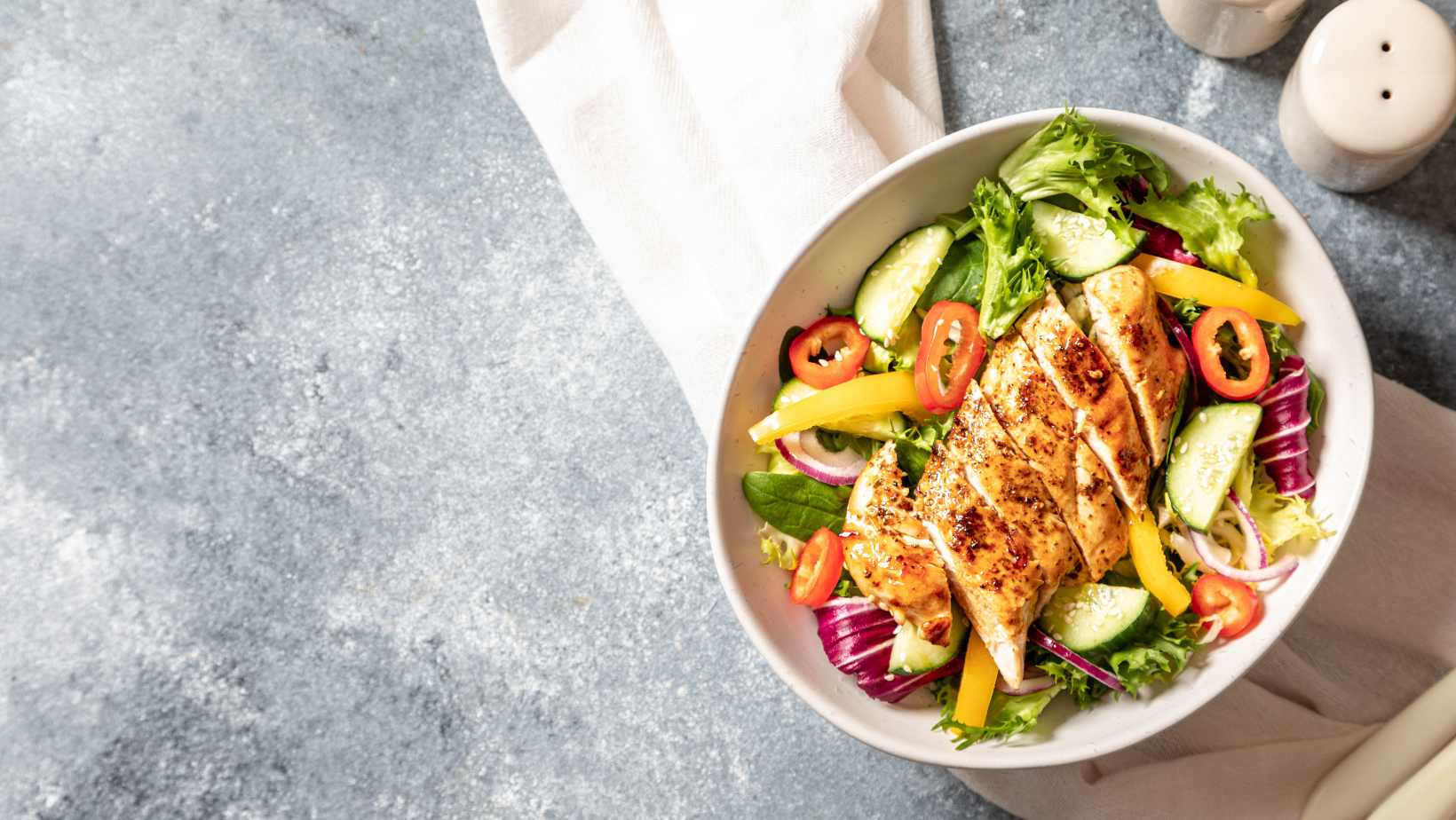Chicken salad can stay fresh in the refrigerator for four days, with a temperature below 40°F. Store it in an airtight container to keep it from spoilage. If you notice any changes in colour, texture or odour, discard it right away.
To make it last longer, store the dressing separately from the salad. This stops the greens from getting soggy. Also, add ingredients with longer shelf life like roasted nuts or dried fruit.
Don’t leave the salad at room temp for more than two hours. Bacteria enjoy warm temperatures. Follow these tips for safe and fresh chicken salad.
Vinegar or lemon has antibacterial properties, so adding them to the recipe helps. Additionally, salt draws out moisture, which reduces bacterial growth. Lastly, use clean and hygienic utensils to avoid cross-contamination.
How Long Does Chicken Salad Last in The Refrigerator
To improve the shelf life of your chicken salad, consider the factors that affect it. When making chicken salad with various ingredients, the freshness and quality of each item can impact the salad’s lifespan. Additionally, the storage conditions of the chicken salad play a crucial role in its longevity. Keep reading to learn more about these two sub-sections.
Ingredients used in Chicken Salad
The ingredients in Chicken Salad affect its quality and shelf life. Each ingredient contributes to the flavour and texture of the salad. Fresh dill adds flavour and aroma.
To make the most of your Chicken Salad, store it between 0-4°C or -18°C. This keeps bacteria away and extends its shelf life for up to two to three days. Always use fresh ingredients before preparing.
For a delicious Chicken Salad that lasts longer, store it correctly and use fresh herbs like dill. Avoid ruining your lunch break with a stomach ache and regret!
Storage Conditions of Chicken Salad
Chicken salad can easily spoil due to factors like temperature, humidity and packaging. So, it’s crucial to store it properly to avoid food-borne illnesses and maintain its quality.
To extend its shelf life, store chicken salad at a temperature of 35-40°F and a humidity level of less than 70%. This decreases bacterial growth and keeps it fresh. Additionally, use an airtight container for packaging to prevent moisture loss.
Furthermore, for safe consumption, make sure to cook raw chicken properly before mixing with other ingredients. And always use fresh ingredients for quality.
Chicken salad is a classic American dish that first appeared in the early 20th century. It’s an all-time favourite for snacks and main course meals. But remember – no one wants food poisoning from expired chicken salad!
Ways to Increase The Shelf Life of Chicken Salad
To increase the shelf life of your chicken salad, follow these techniques for proper storage and preservation. Proper Storage Techniques and Using Preservatives are two subsections that we will discuss in this section to enhance your knowledge of making your chicken salad last longer.
Proper Storage Techniques
For the Chicken Salad to stay tasty and nutritious, you must maintain its longevity. Here are some tips:
- Put it in an airtight container.
- Refrigerate between 35°F and 40°F.
- Stir it often.
- Don’t keep it for more than 4 days.
Also, use fresh ingredients, avoid cross-contamination, and seal the container well. To make it last even longer, put in natural preservatives like Vinegar or Lemon Juice. These can inhibit bacterial growth – and your Chicken Salad will stay fresh and delicious for longer! So make sure you store it in airtight containers – it’ll make a big difference!
Use airtight containers
Hermetically sealed receptacles are great for keeping chicken salad fresh. Airtight containers make it easy to maximise the shelf life of your salad. Here are three tips:
- Close the lid tightly after every use. If not, air and moisture could enter and spoilage could occur early.
- Be careful not to overfill the container. Too many items can cause an imbalance in temperature and bad storage conditions.
- Label and date the container. This will help you keep track of how long it has been stored and prevent mix-ups with other food.
Different types of containers provide different results, so select carefully based on your needs. Plastic containers usually have lower variability in leakage or less constrictive seal design than glass ones. However, make sure to only use high-quality containers with thick walls that can handle extreme temperatures without toxins. Sarah was amazed when she returned from a trip and found her homemade chicken salad still fresh after two weeks. It’s safe to say, warm chicken salad is a surefire sign of food poisoning!
Keep the chicken salad refrigerated
Refrigeration is a must for keeping chicken salad fresh and safe to eat. To do this, follow these steps:
- Place the salad in an airtight container.
- Secure the lid to keep air out.
- Label the container with the date it was made.
- Store it on a lower shelf in your fridge, where it’s colder.
- Don’t pile items on top of it.
- Keep condiments separate until you’re ready to eat.
Check your chicken salad regularly. If it smells off or has an odd texture, throw it away. Refrigerate your salad correctly from the start to enjoy it for days. Don’t let it become a science experiment!
Do not mix fresh ingredients with leftovers
Extending the shelf life of chicken salad requires using fresh ingredients. Mixing fresh and leftovers increases the risk of contamination. Here’s how to maximise the lifespan:
- Never mix freshly cooked chicken with leftovers
- Store fresh and leftovers separately
- Keep all ingredients at safe temperatures
- Use clean utensils and containers
- Label containers with expiration date
Also, dressings and sauces can break down the ingredients faster. So, add them before serving and not when preparing.
These steps can help extend shelf life and avoid wasting food. Store your homemade chicken salad correctly and savour the flavours for days!

Using Preservatives
Using Natural Additives to Prolong Shelf Life of Chicken Salad? It’s possible! Add preservatives to increase its shelf life. But, there are also natural additives which won’t compromise on taste & quality.
- Lemon & lime for a tangy flavour & preservation.
- Herbs like rosemary, thyme & oregano have antimicrobial properties.
- Dried fruits like cranberries & raisins enhance flavour & shelf life.
- Vinegar acts as a natural preservative & creates an acidic environment to slow bacteria growth.
Refrigerating below 40 degrees Fahrenheit also helps slow bacteria growth. Thus, natural additives & proper refrigeration can extend shelf life. Pro Tip: Store in an airtight container to prevent air from getting inside, preventing spoilage. Lemon juice is a great way to keep your chicken salad fresh & yummy!
Lemon Juice
Citric acid, found in lemon juice, is a great way to preserve chicken salad. Here’s how:
- Mix freshly squeezed lemon juice into the chicken salad mix before refrigerating
- Use bottled lemon juice when fresh isn’t available
- Coat the surface of the chicken salad with lemon juice before sealing
- Create a marinade with lemon juice and other ingredients to coat and season the chicken
- Try lime or orange juice instead of or in addition to lemon juice
- Use citric acid powder if no citrus juices are available
Be mindful of how much citric acid you use. Too much can make the chicken salad taste sour and affect its texture.
Chef Alice made a large batch of her chicken salad for an event. She added just under 2 tablespoons of fresh lemon juice to each container before putting them in cold storage. After several days, her salads were still tasty and fresh.
Adding vinegar to chicken salad not only adds flavour but also increases its shelf life. It’s the Beyoncé of all salads – always fresh and fabulous.
Vinegar
Vinegar is an acidic solution that can increase the shelf life of Chicken Salad. Here are five points to consider when adding it:
- Vinegar not only prolongs shelf life, but it also adds a tangy note to the flavor.
- Balances the acidity of homemade mayonnaise and makes it last longer.
- Adding a teaspoon to leftovers before storing will reduce bacteria by lowering pH level.
- Works great with oil-based dressings and fresh veggies, keeping them fresh for longer periods.
- Apple cider vinegar is a better option due to its antibacterial properties for bad chicken smells and freshness.
Use a diluted amount of vinegar and mix it evenly for the best results. Marinating the chicken in vinegar before cooking or boiling adds extra flavour and tenderises the meat. Pickling solution can also add an extra sourness to the dish.
Pickling Solution
Using a vinegar-based solution can extend the shelf life of chicken salad. Its acidity inhibits bacterial growth, keeping the salad fresh. To make this pickling solution, mix 1 cup white vinegar, 2 cups water, 2 tbsp sugar and 1 tsp salt in a saucepan over medium heat, until the sugar and salt dissolve. Cool the solution before pouring it over shredded chicken and other ingredients. Too much vinegar can ruin the taste, so use it with caution for the perfect balance. Tomatoes or lemon juice can further boost the pickling effect, lengthening the shelf life.
Pickling has been used for centuries for preserving food. From Japanese Tsukemono to Filipino Atchara, recipes have been passed down from generation to generation. Make sure your chicken salad doesn’t smell like a science experiment gone wrong!
Signs That Your Chicken Salad Has Gone Bad
To keep your taste buds happy and to avoid falling sick, you need to learn how to identify signs that your chicken salad has gone bad. In order to make your chicken salad last longer in the refrigerator, you must be aware of certain sub-sections that are essential in this process. Check for an off-smell, check for mould on the chicken salad, and check for discoloration to avoid consuming spoiled chicken.
Check for Off-Smell
Detect funky chicken salad with olfactory examination! First, smell for a sour scent that’s out of the ordinary. Also, check for mould or strange colours like grey. Look at the expiry date if it’s expired. Plus, watch out for slimy, mushy, or overly dry textures.
A friend once discovered a container that had been forgotten under the table. It looked alright, but the next day, a nose-stinging scent came from it. Don’t let bad chicken salad ruin your day!
Check for Mould on the Chicken Salad
If you think your chicken salad is spoiled by mould, look for these signs:
- White, green, or black spots?
- Smell if it’s sour or bad?
- Slime?
- Texture or consistency strange?
- Taste test?
- If in doubt, throw it away!
Don’t take the risk! Mould can make you sick.
Store leftovers in an airtight container in the fridge, and use within 3-4 days.
Is your salad brown and green? Time to order takeout!
Check for Discoloration
Is your chicken salad off? Look out for changes in its appearance. This can be intentional or unintentional. You may find dark or off-coloured patches on the surface, which indicate contamination. The colour may appear faded or dull. If you spot a greenish tint on the salad, this could mean bacteria and food poisoning. Black spots on the chicken chunks also point to spoilage.

Sometimes, fermented food produces a bad odour. But other times, there’s no smell. That’s why you must look closely at the food.
Several reports have shown how dangerous it is when people eat discoloured food. A woman who ate lobster bisque ended up with hives – and Vibrio parahaemolyticus and norovirus in her system! So, if you’re ever in doubt about leftover chicken salad, just give it to your enemies – it’s the ultimate revenge!
What to do With leftover Chicken Salad?
To make the most out of leftover chicken salad, it’s crucial to know what to do with it. Here’s the solution- in this section titled “What to do with leftover Chicken Salad?” with “Make a sandwich with leftover chicken salad, Use it as a dip for vegetables or chips, Top off a bed of greens with leftover chicken salad, Make a soup or a casserole out of leftover chicken salad” as sub-sections.
Make a Sandwich with Leftover Chicken Salad
Leftover chicken salad can bring new life to sandwiches! Transform it into various versions, to suit everyone’s tastes. Here’s how:
- Pick your bread – Whole grain or multigrain are the healthiest options.
- Spread on the salad – Add as much as you need.
- Top with greens – Lettuce or spinach will add crunch and nutrition. Add tomatoes, onions, or pickles for extra flavour.
A fun variation is an open-faced sandwich – one slice of bread with butter and then chicken salad. Spice up the dish with herbs like dill or parsley. If you have dietary restrictions, try vegan or vegetarian recipes.
Once, while visiting NYC, I saw my friend make delicious finger sandwiches with leftover chicken salad. They looked great and took little effort. It made me want to try experimenting with leftovers, in creative ways! When the salad gets boring, add a little extra flavour to chips or veggies.
Use it as a Dip for Vegetables or Chips
Need to get creative with your chicken salad leftovers? Transform it into a tasty dip for veggies or chips! Here are some ideas:
- Plop the chicken salad on a plate and adorn it with cut-up raw veg like carrots, cucumber, celery or bell peppers.
- Top baked pita chips or crackers with the chicken salad.
- Mix the salad with cream cheese or sour cream for a creamy, tangy dip that pairs great with tortilla or corn chips.
- Layer the chicken salad and veggie sticks in snack packs for on-the-go dining.
Spice it up with fresh herbs like cilantro, parsley or dill. Add a dash of hot sauce or a squeeze of lemon juice for an extra kick.
For a smooth dip, be sure to drain off any excess liquid before serving.
Put a crown on your king – aka your stomach – by adding the chicken salad to a bed of greens. Yum!
Top off a Bed of Greens with Leftover Chicken Salad
Got too much chicken salad? No worries! Use it for a tasty, healthy meal. Top a bowl of greens with the chicken salad. Add some veggies for more nutrition, and a dressing for flavour. Or mix it with pasta or rice for a filling dish. Freeze any leftovers in an airtight container for later. Try it in a sandwich with avocado and roasted red peppers for a unique flavour combo. Or turn it into a soup or casserole. Yum!
Make a Soup or a Casserole out of Leftover Chicken Salad
Transform chicken salad leftovers into comforting casseroles or soups. Here’s a quick guide!
- Gather ingredients: chicken salad, veggies, stock/pasta.
- Heat oil in a pot. Add aromatics – garlic, onions, celery/carrots. Pour in broth/water and bring to a boil.
- Add herbs/spices for flavour. Keep an eye on the soup consistency.
- For a casserole dish, preheat the oven and mix chicken salad with filling (veggies/rice/pasta/cheese/cream). Grease an oven-safe dish with butter/oil. Bake until golden-brown.
- For added nutrition, incorporate greens into soup. Make casseroles more appealing with colourful veggies and cheese.
Let your imagination run wild. Put excess amounts to good use! Food-skills meet creativity – there’s always room for innovation.

